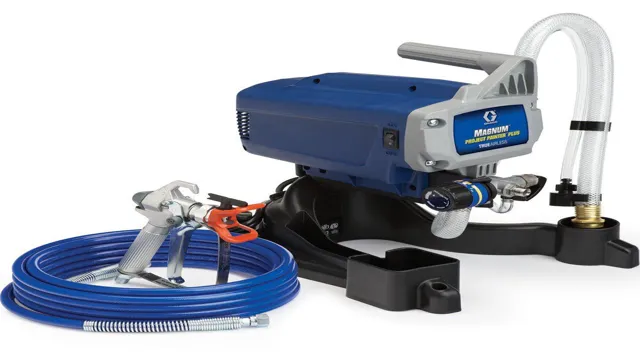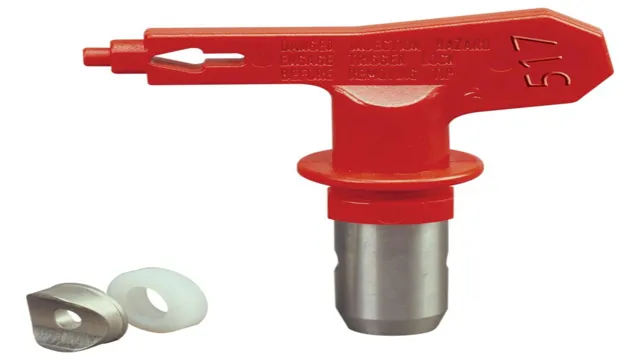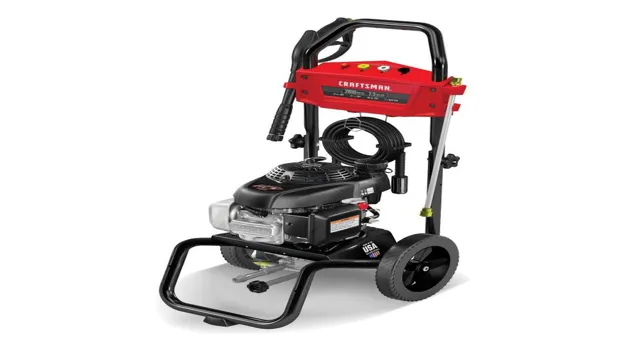
Painting a room or a piece of furniture is a fun way to update or refresh your space. But before you start painting, it’s important to choose the right tool for the job. Using a paint brush or roller can be time-consuming and tiring, which is where a paint sprayer comes in.
Not only is it more efficient, but it also gives a smoother finish and allows you to easily reach difficult areas. But with so many options available on the market, how do you choose the right paint sprayer for your DIY project? Let’s explore the factors to consider to make sure you select the best paint sprayer for you.
Types of Paint Sprayers
Are you wondering which paint sprayer to buy for your next project? There are three major types of paint sprayers to choose from: airless, HVLP, and handheld. Airless sprayers are powerful and efficient but can be difficult to control, making them better suited for large projects. HVLP (high-volume, low-pressure) sprayers are more user-friendly and are ideal for precision work, making them great for furniture and cabinet refinishing.
Handheld sprayers, on the other hand, are the most budget-friendly option and are perfect for small tasks like painting fence posts or small pieces of furniture. Ultimately, the type of paint sprayer you choose depends on the size and complexity of your project as well as your comfort level with each type of sprayer. By considering these factors, you’ll be able to choose the perfect paint sprayer for your needs and achieve a flawless finish every time.
So, which paint sprayer to buy? That depends on your specific needs and preferences.
Airless Paint Sprayers
Airless paint sprayers have become a popular choice for both professionals and DIY enthusiasts due to their versatility, speed, and efficiency. There are two primary types of airless paint sprayers: handheld and stand-mounted. Handheld models are ideal for small to medium-sized painting projects, while stand-mounted models are best suited for larger projects where a consistent finish is desired.
With handheld airless paint sprayers, you have the ability to move around freely and get into tight corners or hard-to-reach areas. Meanwhile, stand-mounted airless paint sprayers are designed for stationary use and provide a consistent finish, allowing you to easily cover large surfaces without any hiccups. Choosing the right type of airless paint sprayer ultimately depends on the size of your project and the level of consistency required in your finish.

HVLP Paint Sprayers
When it comes to paint sprayers, there are different types available in the market. One of the popular options is the HVLP (High Volume Low Pressure) paint sprayers. These devices use a high volume of air to atomize the paint, which results in a lesser overspray, minimal paint wastage, and a finer finish.
There are two types of HVLP paint sprayers: turbine-based and compressor-based. The turbine-based sprayers are more portable, lightweight, and easier to use for small projects. In contrast, the compressor-based sprayers are ideal for large projects and more heavy-duty work.
The choice between these two types depends on the user’s needs and the project requirements. However, both types of sprayers offer precise and consistent results, making them a favorite choice among DIYers and professionals alike. The main advantage of the HVLP paint sprayers is that they are efficient, reduce coating time, and produce less overspray than traditional paint application methods.
Whether you are a DIY enthusiast or an experienced painter, the HVLP paint sprayers can make the painting process more manageable and enjoyable while achieving professional-level results.
Compressed Air Sprayers
Compressed Air Sprayers If you’re looking to paint your house or complete a DIY project, you might be wondering which type of paint sprayer to use. Compressed air sprayers are a popular choice for many people due to their ease of use and versatility. These sprayers are powered by compressed air and come in two main categories: Hvlp (High Volume Low Pressure) and Lp (Low Pressure).
Hvlp compressed air sprayers are ideal for detailed work like painting furniture, cabinets, and trim. They use less pressure, making them perfect for delicate surfaces that require a more controlled paint application. On the other hand, Lp compressed air sprayers are better for larger projects like painting walls, ceilings, and exteriors.
These sprayers use higher pressure and are ideal for covering large areas quickly. While compressed air sprayers have several advantages, they also have some drawbacks. They can be noisy, and overspray can be a common issue.
It’s important to wear protective gear like a respirator and goggles when using these sprayers to avoid inhaling harmful particles. In conclusion, compressed air sprayers are versatile tools that can help make your painting jobs easier and more efficient, depending on the type of job you need to complete. Both Hvlp and Lp compressed air sprayers have unique advantages that make them suitable for different projects.
It’s essential to consider the advantages and disadvantages of using a compressed air sprayer before making a decision, and always prioritize safety while using and operating these tools.
Considerations for Your Project
When it comes to choosing a paint sprayer for your project, there are a few key considerations to keep in mind. The first is the size and complexity of the job at hand – for larger projects, you’ll need a more powerful sprayer that can handle the volume of paint needed. Additionally, consider the type of paint you’ll be using – some sprayers are better suited to thick, heavy paints, while others work best with thinner formulations.
Another key factor is ease of use – look for a sprayer that’s intuitive and comfortable to hold for extended periods of time. Finally, think about maintenance and cleaning – some models require more upkeep than others, so factor in the time and effort you’re willing to invest in keeping your sprayer in top condition. With all these factors in mind, you’ll be able to choose the perfect paint sprayer for your particular needs.
And remember, no matter which sprayer you choose, taking the time to properly prep your surfaces before painting will ensure the best possible results!
Size of Project
When it comes to planning a project, size matters. There are several factors to consider when determining the size of your project, such as the available resources, budget, and timeline. Before embarking on any project, it’s important to assess whether it is feasible and realistic, given the available resources and constraints.
Another critical factor to consider is the scope of the project. Defining the project’s scope will help determine its size and identify any potential challenges that could arise. Taking the time to consider these aspects will ensure that your project runs smoothly and produces the desired results.
So, whether you’re tackling a small project or a large one, it’s essential to carefully consider the size to ensure success.
Type of Paint
When it comes to choosing the type of paint to use for your project, there are a few considerations to keep in mind. Firstly, think about the surface you will be painting on. Different types of paint are formulated for use on specific surfaces, such as wood, metal, or drywall.
Secondly, consider the sheen or finish you want to achieve. High-gloss paints are durable and easy to clean, but may not be suitable for every room or project. Satin and eggshell finishes are more versatile and provide a subtle, elegant look.
Finally, think about the environmental impact and health considerations of the paint. Low VOC or zero VOC paints are available that emit fewer harmful chemicals into the air. By keeping these factors in mind, you can choose the most suitable type of paint for your specific project and needs.
Budget
Project budgeting can be a tricky subject, but it’s essential to your project’s success. When allocating your budget, the first thing to consider is your priorities and what your project needs. It’s important to be realistic about what you can achieve with your budget and avoid overpromising and underdelivering.
Additionally, be sure to factor in any unforeseen expenses that may arise during the project’s life cycle. Working with a professional project manager or accountant can help ensure that you are accounting for all necessary expenditures and that you are using your budget efficiently. With careful planning and budget management, you can ensure that your project runs smoothly and is delivered on time and on budget.
Top Paint Sprayers in the Market
When it comes to choosing a paint sprayer, there are many options available in the market. The first decision you need to make is whether you want an airless or HVLP sprayer. Airless sprayers are great for larger jobs and producing an even coat while HVLP sprayers are best for smaller jobs and providing a high-quality finish.
If you’re looking for an airless sprayer, the Graco Magnum X5 is a reliable and versatile option. It can handle both interior and exterior projects and offers adjustable pressure control for more precision. On the other hand, the HomeRight Finish Max is a top pick for HVLP sprayers.
It’s lightweight and easy to use, making it great for beginners. Plus, it comes with three different spray patterns for ultimate versatility. Ultimately, it depends on your specific needs and the projects you have in mind, but these top picks are a great place to start when deciding which paint sprayer to buy.
Graco Magnum X5 Stand Airless Paint Sprayer
When it comes to painting, having the right tools can make all the difference. If you’re in the market for a paint sprayer, the Graco Magnum X5 Stand Airless Paint Sprayer is definitely worth considering. This top-of-the-line sprayer offers easy setup and cleanup, and the adjustable pressure allows you to customize your painting experience.
Plus, the flexible suction tube allows you to spray directly from a paint bucket, making it perfect for large projects. And if you’re worried about durability, have no fear – the stainless steel piston pump can handle even the toughest coatings. With the Graco Magnum X5, you can get professional-quality results without breaking the bank.
So why settle for anything less? Upgrade your painting game with this top-rated sprayer today.
Wagner Control Spray Max HVLP Paint Sprayer
If you are someone who enjoys DIY painting projects or is a professional painter, having a good paint sprayer can save you a lot of time and hassle. With so many paint sprayers in the market, it can be a challenge to find the right one. One of the top paint sprayers in the market is the Wagner Control Spray Max HVLP Paint Sprayer.
This sprayer is versatile and can handle various types of paints, stains, and lacquers with ease. Additionally, it has an adjustable spray pattern and variable flow control, making it easy to customize your paint job. What’s more, it comes with two air filters to prevent clogging and ensure a smooth finish.
The Wagner Control Spray Max HVLP Paint Sprayer is an excellent option for those who want a high-quality sprayer without breaking the bank. Its ease of use and versatility make it a top choice for DIY enthusiasts and professionals alike.
HomeRight Finish Max C800766 Paint Sprayer
If you’re looking for a paint sprayer that delivers a professional finish, you can’t go wrong with the HomeRight Finish Max C800766 Paint Sprayer. From its lightweight design to adjustable spray patterns, this sprayer has everything you need to tackle any painting project with ease. But what sets it apart from other sprayers on the market? It’s the precision and control you get with every use.
Whether you’re a DIY enthusiast or a seasoned professional, this sprayer can produce excellent results every time. Plus, its easy-to-clean design ensures that you can spend less time cleaning and more time painting. So if you want to save time and effort without sacrificing quality, the HomeRight Finish Max C800766 Paint Sprayer is a top choice to consider.
Conclusion
After weighing the pros and cons of various paint sprayers, it’s clear that the best one for you depends on your individual needs and preferences. Whether you’re a professional contractor or a DIY enthusiast, there’s a paint sprayer out there that will help you get the job done right. Just remember, when it comes to choosing between them all, always opt for the one that makes it sprayin’ and not rainin’.
“
FAQs
What’s the difference between an airless paint sprayer and an HVLP paint sprayer?
An airless paint sprayer uses high pressure to atomize paint, while an HVLP (high volume, low pressure) paint sprayer uses low pressure to deliver a fine mist of paint. Airless sprayers are best for large, exterior projects, while HVLP sprayers are better suited for detail work and smaller projects.
Can I use any type of paint with a paint sprayer?
Generally, paint sprayers can handle most types of paint, including latex, oil-based, and even some specialty paints. However, it’s important to check with the manufacturer’s recommendations before using any special types of paint.
How do I properly clean my paint sprayer after use?
Cleaning a paint sprayer after use is crucial for keeping it in good condition. Run clean water or solvent through the sprayer until it runs clear, then disassemble and clean each part with a brush or cleaning solution. Let all parts dry completely before reassembling.
Do I need to thin my paint before using a paint sprayer?
It depends on the type of paint and the sprayer you’re using. Some paints may need to be thinned with water or a special thinner to achieve the correct consistency for spraying. Check the manufacturer’s instructions for specific recommendations.
How do I adjust the spray pattern on my paint sprayer?
Most paint sprayers have adjustable spray settings, including spray pattern, spray width, and spray volume. Refer to the manufacturer’s instructions for specific adjustments, but usually, a knob or dial on the sprayer adjusts these settings.
Can I use a paint sprayer indoors?
Yes, paint sprayers can be used indoors, but it’s important to take proper safety precautions. Make sure the room is well-ventilated, wear appropriate protective gear like a respirator and goggles, and cover nearby furniture and surfaces to prevent overspray.
How do I maintain my paint sprayer?
Regular maintenance is key to keeping your paint sprayer in top condition. This includes cleaning it thoroughly after each use, checking for wear and tear on parts, and storing it in a cool, dry place when not in use. Refer to the manufacturer’s instructions for specific maintenance guidelines.






